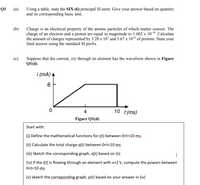Question

Transcribed Image Text:(a)
Using a table, state the SIX (6) principal SI units. Give your answer based on quantity
and its corresponding basic unit.
Q1
(b)
Charge is an electrical property of the atomic particles of which matter consist. The
charge of an electron and a proton are equal in magnitude to 1.602 x 10-19. Calculate
the amount of charges represented by 3.28 x 10' and 5.67 x 102 of protons. State your
final answer using the standard SI prefix.
(c)
Suppose that the current, i(t) through an element has the waveform shown in Figure
Q1(d).
i (mA) A
6.
4
10 t(ms)
Figure Q1(d)
Start with:
(i) Define the mathematical functions for i(t) between 0<t<10 ms.
(ii) Calculate the total charge q(t) between 0<t<10 ms
(iii) Sketch the corresponding graph, q(t) based on (ii)
(iv) If the i(t) is flowing through an element with v=2 V, compute the powers between
O<t<10 ms
(v) sketch the correponding graph, p(t) based on your answer in (iv)
Expert Solution
This question has been solved!
Explore an expertly crafted, step-by-step solution for a thorough understanding of key concepts.
Step by stepSolved in 3 steps

Knowledge Booster
Similar questions
- The assignment asks whether or not these relations are linear or non-linear, can you please inform on how I would figure out whether it is or isn't?arrow_forwardFor an electrical component, the formulas for charge and voltage are given below. A is measured in coulombs, B is measured in seconds, C is measured in volts, and D is measured in seconds. Give the current of this component at t1 = 8 sec. You must round your answer to the nearest thousandth and give your answer as an integer followed by the appropriate metric prefix and the letter that represents the units of current.arrow_forwardWhat is the height in meters of a 5 foot 6.0 inch tall person? marrow_forward
- Force on q, by q, = 79.889N Force on q, by q, = 79.889N 91 O cm 3 4 5 7 8 10 Charge 1 Charge 2 Force Values -4 μC 2 μ Scientific Notation -10 10 -10 10 1 cmarrow_forwardPlease help. This problem involves finding the radius and volume of a platinum atom using its density. Thank you.arrow_forwarda. 2πR2+2πRh2πR2+2πRh b. 2πR2+2πh2πR2+2πh c. πR2hπR2h d. πD2+πDhπD2+πDh e. 2πR+2πRharrow_forward
- In the figure a solid sphere of radius a = 2.40 cm is concentric with a spherical conducting shell of inner radius b = 2.00a and outer radius c = 2.40a. The sphere has a net uniform charge q, = + 6.98 fC; the shell has a net charge q2 = -q1. What is the magnitude of the electric field at radial distances (a) r = 0 cm, (b) r = a/2.00, (c) r = a, (d) r = 1.50a, (e) r = 2.30a, and (f) r = 3.50a? What is the net charge on the (g) inner and (h) outer surface of the shell? (a) Number i Units (b) Number i Units (c) Number i Units (d) Number Units (e) Number Unitsarrow_forwardWhen an object with an electric charge of −0.720mC is 77.0m from an object with an electric charge of −0.200mC, the force between them has a strength of 0.2183N. Calculate the strength of the force between the two objects if they are 231.m apart. Round your answer to 3 significant digits.arrow_forwardthe average density of an atom is approximately 103 kg/m3. The nucleus of an atom has a radius about 10-5 times that of the entire atom, and contains nearly all the mass of the atom. What is the approximate density, in kilograms per cubic meter, of a nucleus?arrow_forward
- Atomic Mass Units and e/u The atomic mass of an isotope is its mass in atomic mass units, where 1 u = 1.661 x 10-27 kg. The ratio of the fundamental charge, e, to the atomic mass unit, u, is e/u = 9.65 x 107 C/kg. 1. Using Atomic Mass Units (a) What is the mass of an isotope with an atomic mass of 19.2 u? m = 31.89e-27 kg (b) What is the charge-to-mass ratio of a +2Li-6 ion, which has an atomic mass of 6.015? 오 = 2.4e6 X C/kg marrow_forwardHow to solve this ?arrow_forwardThe formula for differential volume in a spherical coordinate. a. ? sin ? ?? ?? ??b. ? sin ? ?? ?? ??c. ? sin ? ?? ?? ??d. ? sin ? ?? ?? ??arrow_forward
arrow_back_ios
SEE MORE QUESTIONS
arrow_forward_ios